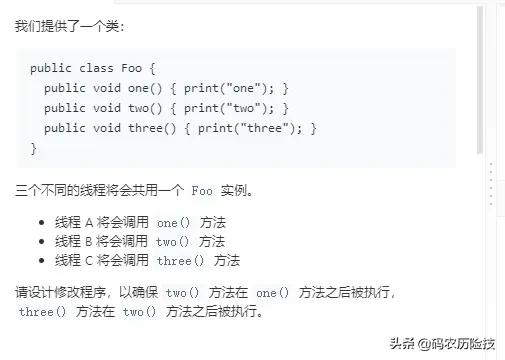
好久没写博客了 。。。。
这道题是典型的设置执行屏障的问题,要确保 two() 方法在 one() 方法之后被执行,three() 方法在 two() 方法之后被执行,对于这道问题的解法我可以直接定义一个变量variable,三个线程分别去监控variable值,当variable=0的时候执行第一个方法,variable=1的时候执行第二个方法,variable=2的时候执行第三个方法。
当variable的值被修改时,其他线程应该要马上能知道variable值的变化,才能做出判断执不执行本身方法,所以variable变量要用volatile关键字修饰来保证线程之间的可见性,比如variable初始值为0,线程A执行方法一,执行完方法一之后把variable的值加1此时variable的值变成了1,由于variable变量用了volatile来修饰,所以线程B马上就能知道variable的值变为了1,所以此时线程B就会调用方法二...
1 class Foo { 2 3 public Foo() { 4 5 } 6 private volatile int variable=0; 7 public void first(Runnable printFirst) throws InterruptedException { 8 printFirst.run(); 9 variable++; 10 } 11 12 public void second(Runnable printSecond) throws InterruptedException { 13 while (true){ 14 if(variable==1) break; 15 } 16 printSecond.run(); 17 variable++; 18 } 19 20 public void third(Runnable printThird) throws InterruptedException { 21 while (true){ 22 if(variable==2) break; 23 } 24 printThird.run(); 25 } 26 }
Leecode上提交结果:
CountDownLatch能够使一个线程等待其他线程完成各自的工作后再执行,这样子我们可以让线程B等待线程A执行完成之后再执行,线程C等待线程B执行完成之后再执行就可以实现按序打印了。
CountDownLatch通过构造函数构造一个计数器来实现,计数器的数值即为为线程的数量,每当一个线程完成了自己的任务后,计数器的值就会减1,计数器值为0时,表示CountDownLatch里面所有的线程已经完成了任务,然后在闭锁上等待的线程就可以恢复执行任务。具体实现看代码注释。
classFoo{ publicFoo(){ } privateCountDownLatcha=newCountDownLatch(1);//信号量a privateCountDownLatchb=newCountDownLatch(1);//信号量b publicvoidfirst(RunnableprintFirst)throwsInterruptedException{ printFirst.run(); a.countDown();//信号量a计数器减1,计数器变为0,表示信号量a执行完。 } publicvoidsecond(RunnableprintSecond)throwsInterruptedException{ a.await();//等待信息量a的线程执行完 printSecond.run(); b.countDown();//信号量b减一,计数器变为0,表示信号量b执行完。 } publicvoidthird(RunnableprintThird)throwsInterruptedException{ b.await();//等待信号量b的线程执行完 printThird.run(); } }
LeeCode运行结果: